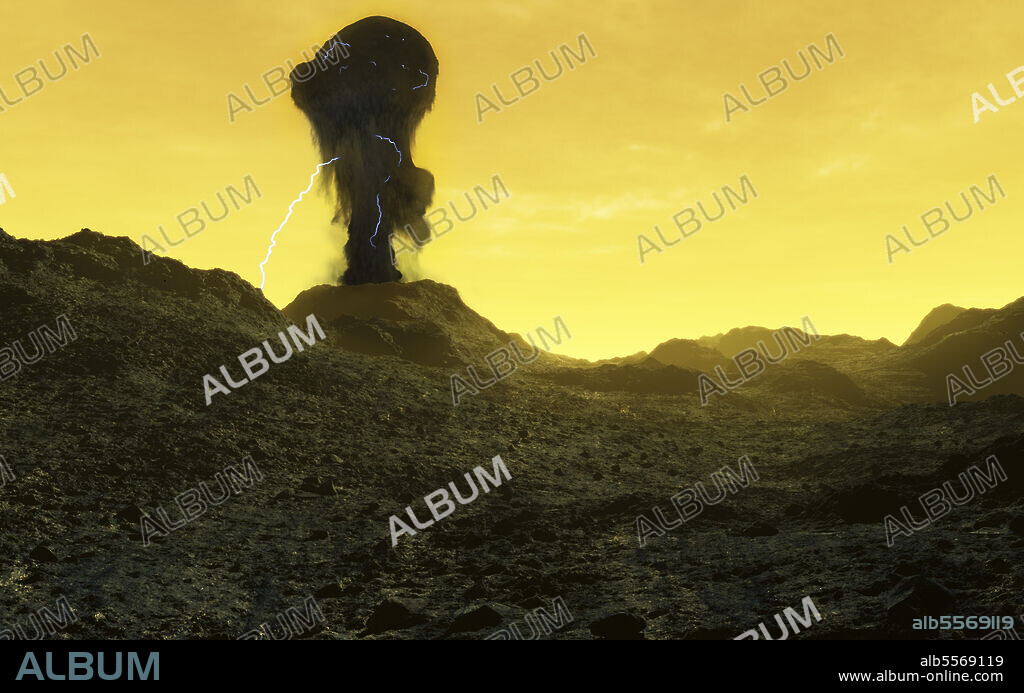alb5569119
The surface of an infernal planet, Venus.

|
Add to another lightbox |
|
Add to another lightbox |



Buy this image.
Select the use:

Title:
The surface of an infernal planet, Venus.
Caption:
The surface of an infernal planet, Venus. Temperatures as high as 500 C (900 K) have been measured. The thick atmosphere, which is about 90 times denser and more massive than Earth's, traps the heat it receives from the sun. This creates a very strong greenhouse effect. The atmosphere is believed to be a consequence of a hypothetic collision with a large body in Venus' past. This collision is also believed to be the reason why the planet rotates backwards, and so slowly that one could walk around the planet faster than it rotates. One day on Venus (243 Earth days) is longer than one year (225 Earth days)!. On the surface, there is little to no wind, but as one ascends into the atmosphere one will find stronger winds and clouds containing sulphuric acid. This sulphur condenses into drops and falls down towards the surface, but the rain drops never reach it, and the heat makes them evaporate into the air again.. Spacecraft that have been sent to Venus have discovered multiple volcanoes, and they have also discovered what they believe is lightning in the atmosphere.
Category:
Space
Credit:
Album / Fahad Sulehria/Stocktrek Images
Releases:
Image size:
5352 x 3345 px | 51.2 MB
Print size:
45.3 x 28.3 cm | 17.8 x 11.2 in (300 dpi)
Keywords:
APHRODITE • ARTWORK • ASH CLOUDS • ASH PLUMES • ASH • ASTRONOMIA • ASTRONOMY • ASTROPHYSICS • ATMOSPHERE • COLOR IMAGE • COLOUR IMAGE • CONCEPT • DIGITALLY GENERATED IMAGE • ERUPTING • ERUPTION • EXTERIOR • GEOLOGIA • GEOLOGY • GREENHOUSE EFFECT • HIGHLANDS • HORIZON OVER LAND • HORIZON • HORIZONTAL • ILLUSTRATION • ILLUSTRATIONS • ILUSTRATION • LIGHTNING BOLT • LIGHTNING BOLTS • LIGHTNING • METEOROLOGY • METEOROLOGY • MOUNTAINOUS • NO PEOPLE • OUTDOOR • OUTDOORS • OUTERSPACE • OUTSIDE • PLANET • PLANETARY SCIENCE • PLANETS • RAY • RAYS • ROCK FORMATION • ROCKY • ROUGH TERRAIN • SKY • SMOKE • SPACE (COSMOS) • SPACE WEATHER • SPACE • SPATIAL • STORM • SULFUR • SULPHUR • SULPHURIC ACID • SURFACE • TEMPERATURE • TERRESTRIAL • TEXTURE • THUNDER • THUNDERSTORM • UNIVERSE • VENUS • VENUS; • VOLCANIC ACTIVITY • VOLCANO • VULCAN • VULCANO • WEATHER • WEATHER: LIGHTNING • WITHOUT PEOPLE
 Pinterest
Pinterest Twitter
Twitter Facebook
Facebook Copy link
Copy link Email
Email
